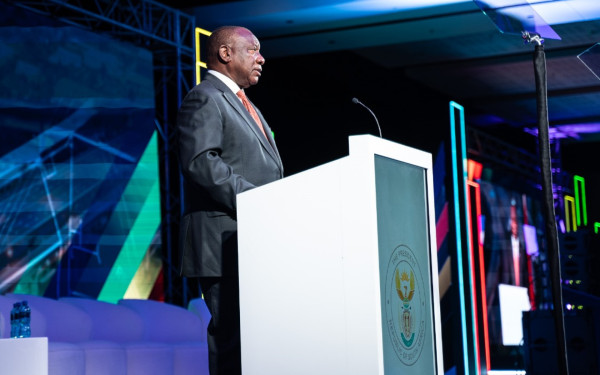Living up to his reputation as a skilled negotiator, South Africa’s President Cyril Rampahosa appears to have outmanoeuvred his main coalition partner – the Democratic Alliance (DA) – in talks over the formation of a new government, while also taking steps to neutralise radical opposition parties demanding the nationalisation of white-owned land.
Mr Ramaphosa announced a 32-member cabinet on Sunday, which saw him keep 20 posts – more than 60% – for his African National Congress (ANC).
In contrast, he gave the centre-right DA six seats – less than 20% – despite the party demanding 30%, following a power-sharing deal it signed with the ANC after the 29 May election failed to produce an outright winner.
But to boost the DA’s representation in the government, Mr Ramaphosa also appointed six of the party’s officials as deputy ministers, including in finance where the ANC’s Enoch Godongwana – respected by both the business sector and trade unions – has remained in charge.
The appointments came after tough negotiations with the DA and a furious exchange of letters, which saw Mr Ramaphosa accuse the party of trying to form a “parallel government” in breach of the constitution.
Mr Ramaphosa further diluted the DA’s influence in the new cabinet by giving another six posts to smaller parties – from the Pan Africanist Congress (PAC) to the Afrikaner nationalist Freedom Front Plus, making it the most ideologically diverse government in South Africa’s history.
In keeping with tradition since the end of the racist system of apartheid in 1994, the government also represents all race groups, with ministerial or deputy ministerial posts given to members of the white, coloured – as people of mixed race are referred to in South Africa – and Indian communities.
This comes after an election in which voters showed that they “don’t care if the cat is black or white, but whether it catches the mice”, political analyst ThembisaFakude told the BBC.
However, there is still resistance to Mr Ramaphosa’s decision to sign a coalition deal with the DA.
Led by John Steenhuisen, the party is often accused of trying to protect the economic privileges that white people built up during apartheid – a charge it denies.
“Oil and water do not mix,” a black security guard told the BBC.
Forming what he called a government of national unity, Mr Ramaphosa also gave a deputy ministerial post to the Muslim Al Jama-ah party, in a clear sign that he intends to continue backing the Palestinians over Israel, despite opposition from the DA.
This perception was strengthened by the appointment of former justice minister Ronald Lamola as foreign minister.
A lawyer, Mr Lamola led South Africa’s opening arguments in the genocide case it brought against Israel at the International Court of Justice.
He takes over from Naledi Pandor, who failed to be re-elected to parliament.
Apart from backing the Palestinian cause, she also strengthened South Africa’s ties with the Brics club of nations, which is seen as a rival to the West, and Russia.
Political analyst Prince Mashele told the BBC he doubted that South Africa would remain a major force internationally, as the ANC had lost its political dominance.
He argued that South Africa’s partners in Brics – including Brazil, Russia, India and China – would “see that they are dealing with a weak partner”.
Mr Ramaphosa was forced to appoint a coalition government after the ANC lost its parliamentary majority for the first time.
He was voted in for a second term by parliament only after the DA agreed to back him in exchange for seats at the top table of government.
The ANC got 40% in May’s election, while the DA came second with 22%.
The DA initially demanded 11 cabinet posts – along with the deputy presidency or the post of minister in the presidency for Mr Steenhuisen.
In the end, Mr Steenhuisen was forced to settle for the post of agriculture minister.
But Mr Steenhuisen welcomed the deal, saying the “DA is proud to rise to the challenge, and take our place, for the very first time, at the seat of national government”.
He said the DA had “refused to accept watered-down compromises and… drove a hard bargain at times to ensure that the portfolios we get are of real substance”.
Mr Steenhuisen’s position is likely to help allay the fears of the country’s white farmers, many of whom feel threatened by the demands of what are now the two biggest opposition parties – former President Jacob Zuma’s MK party and Julius Malema’s Economic Freedom Fighters (EFF) – for the nationalisation of white-owned land.
But the DA leader’s appointment was offset by Mr Ramaphosa’s surprise decision to give the new land reform ministry to the Pan Africanist Congress (PAC) – a former liberation movement which fought white-minority rule under the slogan “Africa for the Africans”.
The PAC waged its election campaign under the slogan “Our land, Our Legacy”, and called for the “decolonization and the restoration of land to its original owners”.
The portfolio, which was previously combined with agriculture, will be held by PAC leader Mzwanele Nyhontso.
The PAC’s decision to serve in government for the first time ever is likely to help Mr Ramaphosa fend off criticism from MK and the EFF that he has betrayed the liberation struggle by forming an alliance with the DA.
